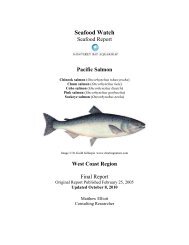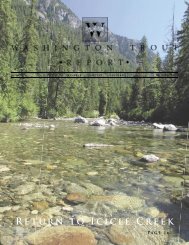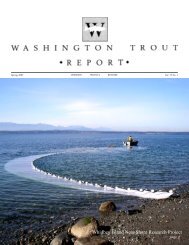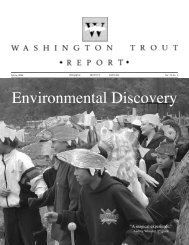Skykomish Draft Final Report - Wild Fish Conservancy
Skykomish Draft Final Report - Wild Fish Conservancy
Skykomish Draft Final Report - Wild Fish Conservancy
Create successful ePaper yourself
Turn your PDF publications into a flip-book with our unique Google optimized e-Paper software.
Chinook and chum were 14% (1 of 7 carcasses examined) and 16% (10 of 63 carcasses),<br />
respectively. The single female coho carcass found in the braided reach was also a PSM<br />
candidate, bearing full and intact egg skeins.<br />
The locations of all salmon redds and carcasses observed during the spawning surveys are shown<br />
in Figs 2–7. The general pattern evident from these maps is that the distribution of salmon<br />
spawning activity is species-specific. Chinook redds were built primarily in the mainstem, often<br />
near the channel bank (e.g. units #7–13 [Fig. 2] and unit #45 [Fig. 4]), while chum redds were<br />
most commonly found within the four side channel networks (Figs 3, 5, 6, 7, 24A). Several<br />
exceptions to this pattern of non-overlapping spawning areas are noted: Chinook and chum redds<br />
were found together within mainstem units #18–20 at the mouth of side channel network SCA<br />
(Fig. 3). The only instance of confirmed chum redds outside the immediate vicinity of a side<br />
channel was in mainstem unit #35 (Fig. 3). Chinook and chum carcasses showed a similar<br />
distribution to that of redds (Fig. 24B). Although largely restricted to distinct spawning areas,<br />
carcasses of the two species were found in proximity within side channel SCB, resembling the<br />
adjacent mainstem in its habitat unit diversity (Fig. 3), as well as in a seasonal backwater channel<br />
in the vicinity of mainstem units #42–44 (Fig. 4) and in the lower reaches of side channel SCC<br />
(Figs 5, 7). A large proportion of chum redds were occupied by live spawners (93% of mainstem<br />
redds and 86% of side channel redds), whereas Chinook redds contained live fish less frequently<br />
(22% in mainstem; 57% in side channels) (Fig. 24A).<br />
The habitat preferences of spawning salmon in the braided reach were examined in detail by<br />
analyzing the physical characteristics of redd sites. The majority of Chinook redds were<br />
observed in glides, while a large proportion of chum redds were built in pools; for both species,<br />
riffle habitats were also frequently selected for spawning (Fig. 25A,B). Chinook redds were<br />
constructed almost exclusively in large cobble; chum salmon utilized a variety of substrates,<br />
including cobble, gravel and sand (Fig. 25C,D). The depth of water in which redds were<br />
constructed did not differ significantly between Chinook (mean 13.4 in.) and chum (mean 16.4<br />
in.) (t-test: d.f.=116; P=0.09).<br />
Washington Trout’s spawning surveys were generally more extensive in their geographic<br />
coverage than were snorkel surveys within a given channel system. Accordingly, the spawning<br />
surveys provided information about fish use that helped refine the distributional data obtained<br />
from snorkel surveys earlier in the year. For example, the small left-bank braid of the mainstem<br />
at habitat units #38–39 was dry during summer 2004 and excluded from snorkel surveys. In<br />
November, the same channel was found to contain the highest density of chum salmon redds<br />
within the braided reach (Fig. 4).<br />
Sources of Sampling Bias<br />
Discussion<br />
<strong>Fish</strong> Abundance and Density<br />
<strong>Fish</strong> counts obtained by snorkel survey typically underestimate the “true” number of fish present<br />
in a habitat unit as determined by more accurate methods of measuring fish abundance (e.g.<br />
electrofishing/removal, mark–recapture) (Rodgers et al., 1992). The calibration recommended<br />
by Hankin and Reeves (1988) involving adjustment of snorkel counts by the ratio of “true” fish<br />
numbers to snorkel estimates was not performed in this study because exhaustive removal<br />
methods were not feasible in the large habitat units surveyed (see also Thompson and Lee, 2000;<br />
9






